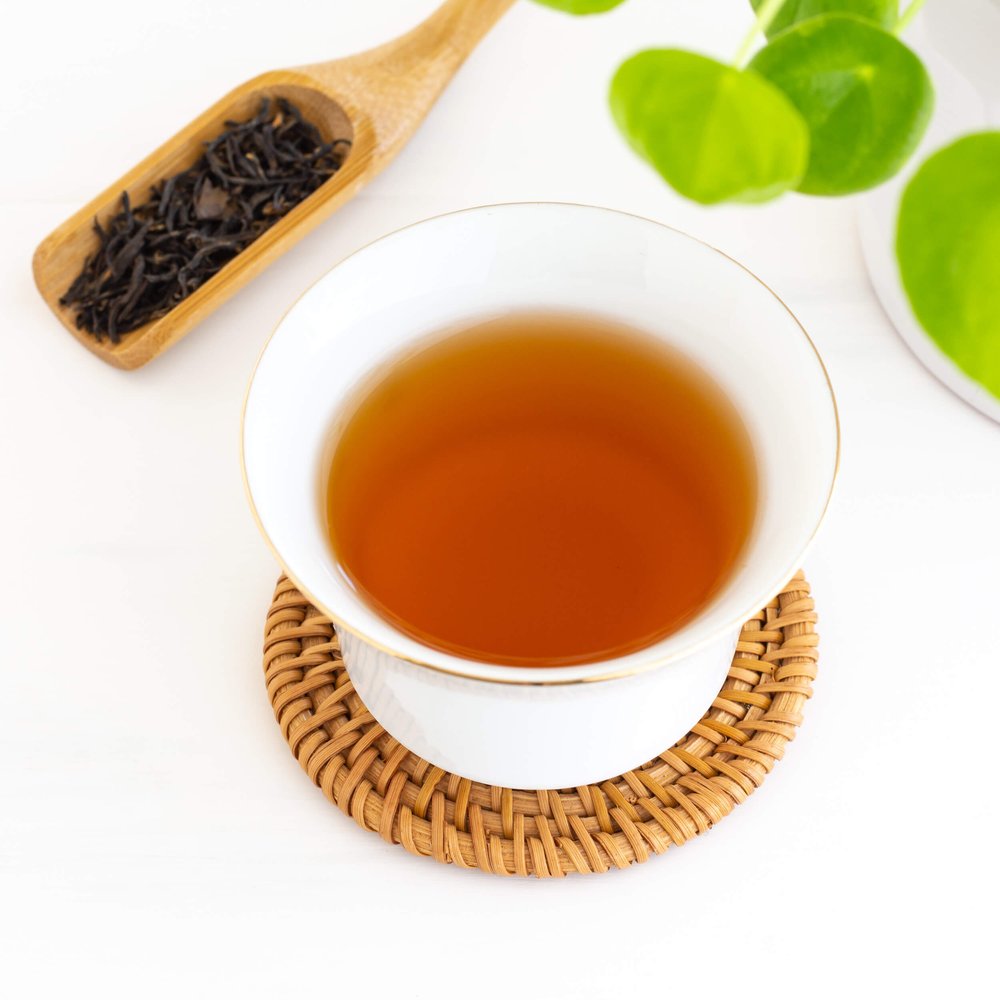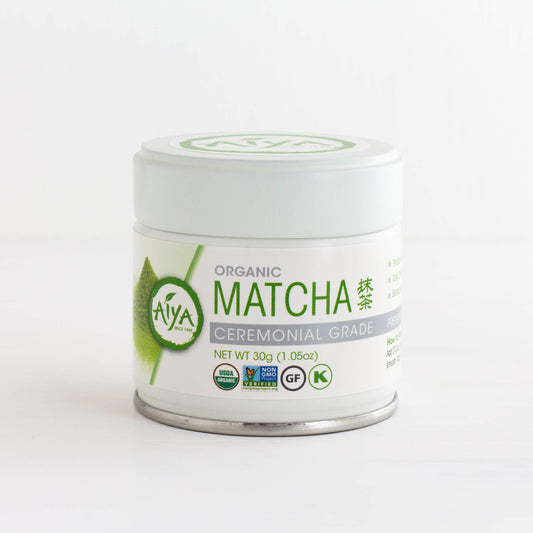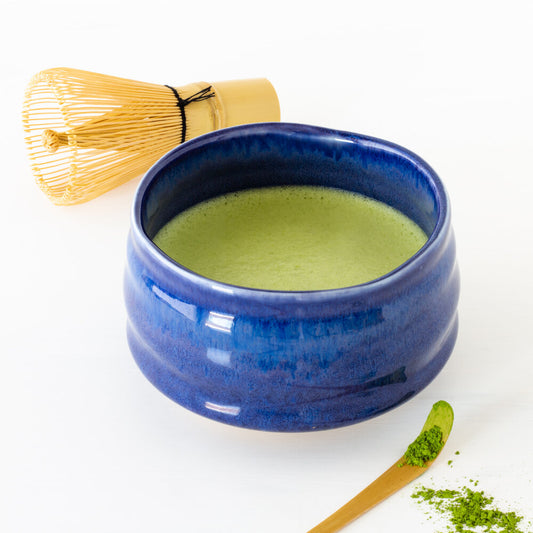Matcha tasting notes
Wondering what matcha tastes like? You’re not alone. Many of our customers are familiar with matcha, whether on its own, as an ingredient in tea lattes, or as a flavoring for baked goods and other concoctions. But they may not know exactly what high-quality matcha tastes like, or they may be apprehensive that it will be too strong or bitter for their palate.
While pure ceremonial grade matcha definitely has a bold flavor profile, it’s also full of a surprising amount of nuance. When prepared as part of the traditional Japanese tea ceremony, matcha is carefully shared and savored among friends using a ritualized preparation method. By taking a moment to slow down and really focus on the experience of drinking matcha and the different tasting notes present in the tea, you can unlock new depths of flavor!
1. Vegetal: grassy, steamed green notes
One of the most prominent tasting notes in high quality matcha is a grassy, vegetal flavor. Matcha is made from green tea leaves that are harvested, steamed, and stone-ground into a fine powder. The steaming process, common to Japanese green teas, results in stronger vegetal notes than Chinese green teas, which are pan-fired and tend to be nuttier and milder as a result.
Because it’s made from whole ground tea leaves, matcha is often described as having an even stronger and more concentrated “green tea” flavor.
2. Umami: savory, oceanic notes
Another indicator of high quality matcha is a pronounced umami flavor. Umami is a rich, savory flavor also found in foods like bone broth and miso soup. When present in matcha, this umami flavor is also sometimes described as oceanic, similar to seaweed.
The shading process that matcha tea plants undergo contributes to their umami flavor. These plants are shaded for up to three weeks prior to harvest, which increases the chlorophyll levels in the plants and produces a rich, savory flavor. It also increases the levels of caffeine and l-theanine. Kabusecha and Gyokuro are two other prominent examples of shade-grown Japanese loose leaf green tea.
3. Sweet: a subtle natural sweetness
Matcha has a subtle, lingering sweetness. While pure matcha won’t be as sweet as, say, a matcha latte, it has a light natural sweetness that helps to balance out the other strong flavor notes present in this unique tea. In the traditional Japanese tea ceremony, matcha is often served alongside small sweets, which help to accentuate the sweetness naturally present in the tea.
4. Bitter: sharp notes with an astringent bite
Matcha has a slight earthy bitterness. While low quality or improperly prepared matcha can be unpleasantly bitter, the best matcha has subtle bitter notes that combine with and complement the other flavors in the tea. Matcha also has a pleasantly astringent bite.
5. Smooth: buttery and rich notes
Smoothness is another characteristic of good ceremonial grade matcha. Matcha is often described as smooth, rich, and almost buttery, with a full body and lingering aftertaste. If you’re preparing matcha using a traditional method, using a matcha sifter and whisking your matcha using a matcha whisk can help to ensure that your matcha is smooth, rich, and frothy rather than thin and clumped together.
What factors affect the taste of matcha?
There are a few different factors that can influence what your matcha tastes like. These include what kind of matcha you're using, how much you're using, how old your matcha is, the water temperature you're using when preparing your matcha, and more.
The type of matcha you use
Ceremonial grade matcha and culinary grade matcha are made from the same plant, but they're intented for different purposes. Culinary grade matcha is designed to be used in smoothies, lattes, baked goods, and more. For this reason, it has a stronger, bolder flavor that can stand out even when combined with other ingredients.
On the other hand, ceremonial grade matcha is designed to be consumed on its own, whisked up with hot water. Ceremonial grade matcha is often a little more sublte in its flavor. It also typically has enhanced umami notes.
How much matcha you're using
A little bit of matcha powder goes a long way! If you use too much matcha, your drink may be overly strong or even bitter. On the other hand, if you don't use enough matcha powder, it may be weak and lacking in flavor. We recommend using about one teaspoon of matcha powder per 12 oz. of water.
How old your matcha is
Matcha typically lasts about one to two years in peak condition. To extend the life of your matcha, we often recommend storing it in the fridge or keeping it somewhere cool and dark. Fresh matcha is bright green and subtly sweet, with pronounced oceanic notes. Older matcha may taste slightly stale, bitter, or lacking in flavor.
Your water temperature
When preparing matcha, avoid using boiling water! Very hot water can make matcha taste bitter and burnt. Instead, use water that is steaming but not yet boiling, approximately 175 degrees.
Pairing matcha with food
One way to accentuate certain flavors within high quality matcha is to enjoy it alongside other dishes. Flavors that go with matcha include sweet treats like traditional Japanese wagashi sweets, fruits like mango and berries, and savory dishes that incorporate umami-forward ingredients like miso and soy sauce.
About matcha
Matcha is a fine powdered tea with a bright, emerald green color and a rich, vegetal taste. It’s made from stone-ground green tea leaves and produced in Japan. Matcha tea plants are shaded for at least three weeks prior to harvest. After the leaves are harvested, they are then steamed, stone-ground, and packaged for sale.
Powdered green tea was first produced in China, but was introduced to Japan in the 12th century. Matcha is an important part of Japanese culture, and the traditional Japanese tea ceremony is used to prepare matcha using a ritualized method developed over the course of centuries. Matcha can be enjoyed on its own, and is also a popular ingredient in lattes, smoothies, and baked goods.
Ceremonial vs. culinary grade matcha
Matcha comes in two main grades or categories: ceremonial grade matcha and culinary grade matcha. Ceremonial grade matcha is designed to be enjoyed on its own, and has a subtle and complex flavor. Culinary grade matcha is designed to be added to smoothies and other concoctions, and has a bolder flavor. Both types of matcha are tasty, and there’s no one type of matcha that is necessarily “better” than the other. They each have different purposes and strengths!
Matcha tea benefits
Matcha contains a concentrated amount of the many benefits of green tea. These include:
- High in EGCG
- Boosts energy
- Reduces stress
- Improves cognitive function
- Good for your teeth
- Good for your metabolism
- High in antioxidants
- Good for your heart
- Improves longevity
- Good for your skin
- Boosts your immune system
- Reduces inflammation
- Good for digestion
How to prepare matcha
To make matcha at home, heat cold, filtered water to approximately 175 degrees. Scoop the matcha powder into a sifter using a matcha scoop (we recommend about two scoops, or approximately one teaspoon, of matcha powder per bowl.) Sift the powder into your matcha bowl, then add a small amount of hot water and use a bamboo matcha whisk to whisk the tea until a smooth paste is formed. Then add up to 6 ounces of water, and whisk until frothy.
New to the world of matcha and not sure where to begin? Our matcha starter kit contains everything you need to make matcha at home, including a tin of ceremonial grade matcha, matcha bowl, scoop, whisk, whisk holder, and sifter.
Shop Our Matcha Collection >>>
FAQs
Have questions about matcha? We have answers!
Does matcha taste like green tea?
Matcha is often described as having an even stronger and more intense green tea flavor. This is because you’re consuming the entire tea leaf when you drink matcha.
Is matcha sweet?
High quality matcha has a light natural sweetness. While it’s not sweet like sugar or candy, you can definitely taste subtle sweet notes.
Does matcha taste like fish?
While it may sound a little strange, matcha does have oceanic, umami notes reminiscent of the sea. Although it doesn’t have an unpleasant “fishy” taste, it can taste a little like seaweed.
What is matcha made out of?
Matcha is made out of shade-grown, stone-ground Japanese green tea leaves. These teas are shaded for several weeks prior to harvest, then steamed and ground into a fine powder.
Does matcha have caffeine?
Matcha is high in caffeine, containing about as much as coffee per cup. The shading process increases the caffeine and l-theanine content in this tea. Although it’s relatively high in caffeine, matcha is often described as having a calmer and more sustained energizing effect than other high-caffeine beverages.












